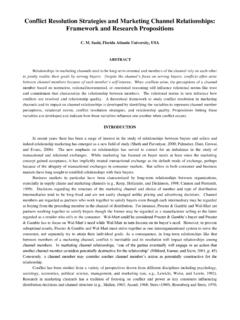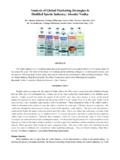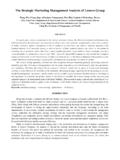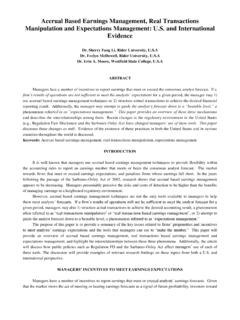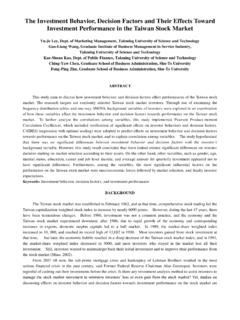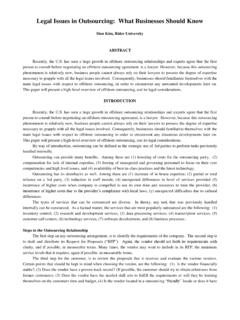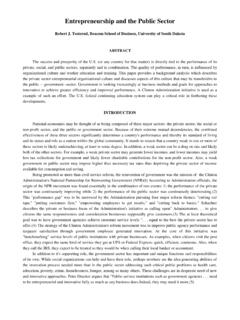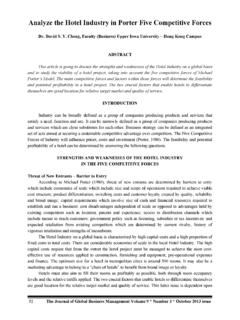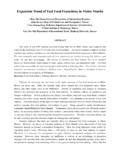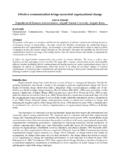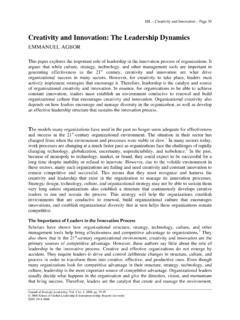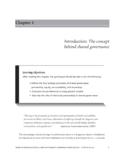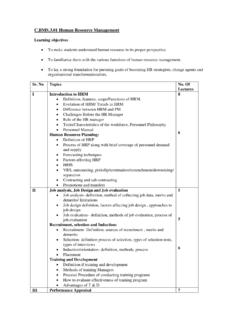Transcription of Individual Resistance from Employees to …
1 Individual Resistance from Employees to organizational Change Dr. Chuang,Yuh-Shy, International Business Department, Ching Yun University ABSTRACT. Core competitiveness is the capability of a company to survive while facing strong competition, not only from inside the country but also from international corporations. Even small or medium businesses facing strong rivals typically must be able to make changes quickly to maintain their competitiveness. These kinds of organizational changes are not only small ones, like adding a new person or modifying a program at one department, but are often organization-wide changes. Resistance to both small and large change is one of the important factors that can influence the success of implementing any organizational change, including new technology innovations, new policies, and new organizational structure. In this paper, we will review the studies of Resistance to change and research the theories of Individual responses and Resistance to change.
2 It is important to understand the reaction of employee responses to change over time and to understand how to reduce Resistance to change through managing change processes. Keywords: organization change, Resistance to change, Individual respond. INTRODUCTION. Core competitiveness is the capability of a company survive while facing strong competition, not only from inside the country but from international corporations. Even small or medium businesses facing strong rivals typically must be able to make changes quickly to maintain their competitiveness. These kinds of organizational changes are not only small changes, like adding a new person or modifying a program at one department, but are often organization-wide changes. Resistance to both small and large changes is one of the important factors that can influence the success of implementing any organizational change, including change in mission, restructuring operations, inputting new technologies, mergers, major collaborations, downsizing, new programs such as Total Quality Management, re-engineering, and new organizational structure.
3 organizational transformation may keep the company in business, but will Employees understand it if it is a fundamental and radical reorientation in the new way the organization operates? Because of the likelihood of employee Resistance , change should not be done for the sake of change but to accomplish some overall or specific goal. organizational change is usually provoked by some outside driving force, such as substantial cuts in funding, major new markets, a need for dramatic increases in productivity and/or services, or a strong new competitor in the market. Typically, organizations must undertake organization-wide change to evolve to a different level in their life cycle. Such changes might take the form of transition to a new chief executive, who can institute organization-wide change when his or her new and unique personality pervades the entire organization. Organization-wide change often goes against the values held by members of the organization how members believe things should be done.
4 Often, organization-wide change is difficult and provokes strong Resistance because people are afraid of the unknown, they don't share a vision of the future, or they don't understand the need for change. Many are inherently cynical about change, particularly from hearing about the notion of "change" as if it's a mantra. Many doubt there are effective means in place with which to accomplish major organizational change. Often there are conflicting goals in the plan for organizational change, , increasing resources to accomplish the change while cutting costs to remain viable. There are many discussions in the literature about Resistance to change, focusing on how change requires the culture of the organization to change first, including changes in Employees ' values and beliefs and in the way they enact these values and beliefs. In this paper, we will review the studies of Resistance to change and research the theories of Individual responses and Resistance to change.
5 It is important to understand the reaction of employee responses to change over time and to understand how to reduce Resistance to change through managing change processes. LITERATURE REVIEW. The Necessity for organizational Change in Global Business Adapting to changing goals and demands has become less of a challenge for organizations facing global competition, but the task seems to have become more complicated in terms of ensuring in advance that Employees can handle the change. In the profit sector, global market share growth and political shifts have opened more new markets for products and services than ever before. To respond to the pace of change, organizations are adopting flatter and more responsive and agile structures and more empowering, team-oriented cultures. As a result, Employees are coming to expect involvement in decisions about organizational change. Successful organizational adaptation is increasingly reliant on generating employee support and enthusiasm for proposed changes, rather than merely overcoming Resistance .
6 Mintzberg and Waters (1985) pointed out the influence of participation on a set of dimensions related to the success of the implementation of deliberate strategic change. Participation is believed to have a number of positive effects on the strategy process; most notably, involvement of those affected by a change in strategy will reduce organizational Resistance and create a higher level of psychological commitment among Employees towards the proposed changes. Also, participation leads to qualitatively better strategic decisions (Kim and Mauborgne, 1998). Why Employees Resist Change Resistance to change has been recognized one of the important factors that can influence the success of organizational changes, including new technology innovation, new policies, and new organizational structure. Maurer (1996) indicated that half to two-thirds of all major corporate change efforts fail, and Resistance is the little-recognized but critically important contributor to that failure.
7 Recent studies of Resistance to change have focused on behavior reaction. Brower and Abolafia (1995) defined Resistance as a particular kind of action or inaction, while Ashforth and Mael (1998) defined it as intentional acts of commission (defiance) or omission. Shapiro, Lewicki, and Devine (1995) noted that willingness to deceive authorities constitutes Resistance to change, while Sagie, Elizur, and Greenbaum (1985) used compliant behavior as evidence of reduced Resistance . Although the concept of Resistance to change has been well discussed, the concept has limitations. Jermier, Knights, & Nord (1994) argued that the interests of managers should not be privileged over the interests of workers when processing organizational change. Block (1993) pointed out that Resistance may occur when people distrust or have past resentments toward those leading the change and when they have different understandings or assessments of the situation.
8 O'Toole (1995). reported that Resistance to change is an effort to protect established social relations perceived to be threatened. Spector (1989) pointed out that Resistance occurs because it threatens the status quo or increases the fear of and anxiety about real or imagined consequences (Morris and Raben, 1995). Bryant (2006) stated that change threatens personal security and confidence in an ability to perform. Moreover, change may also be resisted because it threatens the way people make sense of the world, calling into question their values and rationality and prompting some form of self-justification or defensive reasoning. Graham (1986) noted that some employee Resistance to organizational actions is motivated by more than mere selfishness such as lack for future vision, short of capability, fear of relocation. Managers in charge of rolling out a change initiative often blame others for the failure of the initiative, rather than accepting their role in its failure.
9 Employees are likely to do the same thing, assigning blame for failed change attempts to their managers, rather than themselves (Argyris, 1990). Dealing successfully with Resistance depends on an ability to represent the change accurately, to describe the source of Resistance in the Individual , and to choose and implement strategies appropriate for addressing and overcoming that source. It is often assumed that everyone in an organization shares the same objective and homogeneous reality, but not all participants facing a change initiative encounter the same conditions. Differences in participant responses to change usually reflect either misunderstandings about the change or Individual characteristics and attributes. Watson (1982). pointed out that managers often perceive Resistance negatively, since they see Employees who resist as disobedient; even if they see Employees who oppose change as short-term problems in processing the change, managers are tempted to treat their subordinates as obstacles.
10 Understanding the reasons for Resistance to change can help managers prevent disaster and improve the change's chances for success. There are many reasons why Employees may react negatively to change. Personal loss. Right or wrong, people are afraid they will lose something, particularly: Security - a concern about job loss through a reduction in force or automation.. Money a concern about loss of money through a reduction in salary, pay, benefits, or overtime or through increased expenses because of a move to another location that is farther from their home. Pride and satisfaction a concern about ending up with jobs that no longer require their abilities and skills, such as automation through computer-aided design in engineering departments ( , a "button pusher" instead of a "skilled craftsman"). Friends and important contacts a concern that a move to another location will no longer allow contact with friends and important people, resulting in loss of visibility and daily contacts.
